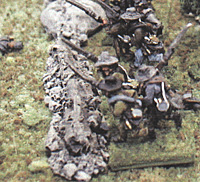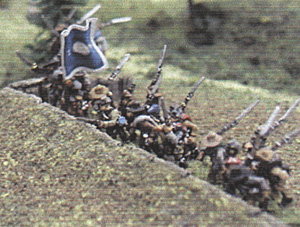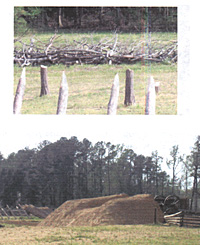 The American Civil War was approaching its third bloody year before field fortifications came into regular use. With battlefield tactics resulting in incredible bloodshed, troops and forwardthinking leaders began to find ways to provide better cover. Sure, fortified positions existed, but few earthworks were erected by troops as a regular battlefield practice.
The American Civil War was approaching its third bloody year before field fortifications came into regular use. With battlefield tactics resulting in incredible bloodshed, troops and forwardthinking leaders began to find ways to provide better cover. Sure, fortified positions existed, but few earthworks were erected by troops as a regular battlefield practice.
This all changed during the campaigns of late 1862 and early 1863. We see some Confederate units erecting earthworks at Fredericksburg, and both armies erected field fortifications at Chancellorsville. Fieldworks also saw limited use at Gettysburg and Chickamauga. "In the winter of 1863-64, soldiers on both sides of the American Civil War learned the value of temporary field entrenchments. It did not result from any articulated shift in tactical doctrine, but rather seems to have emerged out of a spontaneous recognition by veteran troops that to dig was to survive." [1]
As the 1864 campaigning season began, field fortifications became the norm in both Georgia and Virginia. Grant, commenting afterward about the Overland Campaign of May-June 1864, observed of the Army of the Potomac that " in every change of position or halt for the night, whether confronting the enemy or not, the moment arms were stacked the men entrenched themselves. For this purpose they would build up piles of logs or rails if they could be found in their front, and dig a ditch, throwing the dirt forward on the timber... It was wonderful how quickly they could in this way construct defenses of considerable strength.." [2]
Grant confidant and aide, John Rawlins, wrote to his wife in May 1864 that a "few hours always suffice for an army acting purely on the defensive to fortify itself, and the fortifications make up greatly for inferiority of numbers."
[5]
As troops began regularly entrenching, their methods improved from trial and error. During the battle of the Wilderness, General Hancock's men came into line along the Brock Road and began to dig. According to a member of the Philadelphia Brigade, "The troops on the road commenced strengthening their position with logs, dead trees and other debris of that character, of which there was an endless supply." [6]
As the months of combat wore on, the troops became faster, and often began entrenching without orders to do so. General Alexander described how the men dug ad-hoc entrenchments during the battle of Cold Harbor: "While Kershaw made his attack, the remainder of the long column halted in the road, expecting the march to be presently resumed. But when the delay was prolonged, and a few random bullets from the front began to reach the line, without any general instructions, the men here and there began to dig dirt with their bayonets and pile it with their tin cups to get a little cover. Others followed suit, and gradually the whole column was a work entrenching the line along which they hafted. [7]
While it was easier to use a line such as a fence to build on, troops often constructed their works with rocks (even converting rock walls), logs, trees, and any other similar object. Undoubtedly, using the above materials would speed construction of a line of works, but in most cases, dirt/earth was heaped onto the pile to provide greater protection. In fact, when no other objects were available, men would dig and make earthen entrenchments. "There were few, if any spades or shovels, but the men split their canteens, making scoops of them, and together with the bayonets and their hands, for the soil was light and sandy, soon had a very respectable earthwork thrown up," noted one of Breckinridge's soldiers. [9]
Once the troops had constructed their hasty entrenchments, the work would continue to improve the defenses. As the veteran soldiers began to appreciate earthworks, they also became effective combat engineers or sorts. Trees would be cut from in front of the entrenchments, trimmed of the upper branches, and hauled in sections to the earthworks. The sections of the trunks would be used to reinforce the inside of the works, providing greater strength and protection, and allow the works to be constructed higher.
Earth would then continue to be dug from behind the works and thrown on the front side. This achieved two purposes - increasing the height, and providing a "trench" for the soldiers to further protect themselves. The upper branches of the trees would then be sharpened, pointed towards the enemy, and anchored by the stumps. This slashing, or abatis, would have the effect of disrupting the formation of any attackers, allowing the defenders to shoot down the attackers as they worked their way through the sharpened branches. Finally, the now cleared area provided the defenders with increased visibility and field of fire.
From this point the works would become stronger in nature, often described as light or medium works. Head logs would be installed, transverses dug, and other facilities constructed. All of this construction occurred in a relatively short amount of time.
Johnny Reb III treats hasty works or entrenchments favorably by providing a +I DRM for the firer, a -3DRM to defense, and a -2 morale modifier for the defender. Furthermore, they will disorder the attacking force and cause the attacker to lose movement off of his charge total. JR III only allows hasty works to be built along a fence or wall, or in a wooded or brushy area where small trees were available. To construct hasty works, a unit must make a tactical competence roll (modified by an officer, if available) and then twice the unit's BMP to build the works in consecutive turns (unless assisted by pioneers/engineers). If interrupted, the rules call for the unit to start these consecutive turns again. Other JR features concerning hasty works include the ability for enemy units to destroy the hasty works, and to even turn the works.
From my experience, hasty works are often best placed at the start of a scenario. Not many gamers attempt to build works due to the supply of troops and/or the scenario length. When initially placed as part of a scenario, hasty entrenchments can have abatis and other defensive upgrades. We often treat these works as "Light Earthworks" to provide a middle point between Hasty and Medium works. When using light works, artillery does not get a -1 DRM when targeting units in the works. Artillery can only destroy the works as though they are medium works. Finally, light works cannot be destroyed by infantry, as hasty works can.
The construction of hasty works can be very difficult to accomplish due to the length of time needed, plus the required tactical competence roll. Some alternatives are to lower the number of turns needed to build hasty works. Veteran troops in 1864-65 should be able to readily build hasty works. The length of construction time required can equal the BMP plus 1, as an example. Interrupting troops building works can also be altered to allow units, which do not move away, to continue construction after interruption. Perhaps a unit interrupted when '' V2 or greater into the construction process can have works with a lower rating, such as the equivalent of a stonewall.
Other options for use of works are to allow them to be built in all kinds of terrain. However, units building works on a stonewall, fence, or in the woods/rough terrain could cut construction time in half, due to the materials which will help raise an embankment quicker. Finally, abatis can cause disorder whenever crossed.
Defenders in works have the option of spreading out in extended lines. Always remember to leave a reserve to help drive out disordered attackers who manage to get into the works. Try a double line for the reserve units.
Attackers will need to coordinate their efforts, and prevent the defenders from stripping other defenses of troops to help defend the threatened points. Attackers should use successive charges and/or wave assaults. Regular lines provide more elan, but extended lines provide greater movement distances. Beware if you decide to use Attack Columns for your attacks. They suffer heavy casualties with dubious results.
Creating hasty works to use on your miniature battlefield can be very easy. These can be simulated by laying small "logs" and downfall on the battlefield to mark hasty works. Small sections of works can also be created by using thin basswood, card stock, or plastic sheet. Sections of bases can be cut and decorated with logs, fence rails, rocks/stones, cotton bales, and/or dirt. You can create dirt a number of ways, but I like using textured artist gel mediums. These provide a great dirt-like look, which can be built into the pieces. Once dry, the pieces can then be primed and painted to achieve the look you desire.
Some commercially available products include the resin hasty works I created at Battlefield Terrain Concepts (sorry - shameless plug here). Options available (sorry only 10mm - 20mm currently available) include piled earth, piled rail and earth, piled earth and logs, rocks/stones and logs, and finally, cotton bale defenses with earth. Note that cotton bales were frequently used in the far south to aid in the erection of defenses. For example, much of the Confederate redoubts at Vicksburg were constructed with the assistance of cotton bales. These resin works are inexpensive and easy to finish. Simply paint them, flock them, and use them how you would like.
If you have not enjoyed a game with hasty works, give them a try. They add variety to a scenario and can be very challenging to attack. After alll, almost 1/3 of the war will be missed if you avoid using hasty works in your ACW gaming..
[1] Trudeau, Noah Andre, "The Walls of 1864," essay in With My Face To the Enemy (New York: G. P. Putnam's Sons, 2001), Page 413.
 This discovery of entrenching was not limited to Billy Yank. Federal staff officer Lt. Col. Theodore Lyman remarked during the Overland Campaign, "It is a rule that, when the Rebels halt, the first day gives them a good rifle-pit; the second a regular infantry parapet with artillery in position, and the third a parapet with an abatis in front and entrenched batteries behind." [3]
This observation was seconded by a Johnny Reb, Alexander Hunter, who said, "No sooner would a line be formed when the enemy was near, than every man was busy throwing up a mound of dirt for protection."
[4]
This discovery of entrenching was not limited to Billy Yank. Federal staff officer Lt. Col. Theodore Lyman remarked during the Overland Campaign, "It is a rule that, when the Rebels halt, the first day gives them a good rifle-pit; the second a regular infantry parapet with artillery in position, and the third a parapet with an abatis in front and entrenched batteries behind." [3]
This observation was seconded by a Johnny Reb, Alexander Hunter, who said, "No sooner would a line be formed when the enemy was near, than every man was busy throwing up a mound of dirt for protection."
[4]
 Troops generally constructed hasty entrenchments out of any material at hand that would stop a bullet and provide some protection. Often a fence was quickly converted into a line of works. "A windrow of rails from the adjacent fences was laid; such spades and mattocks as they had were wielded by willing hands; and bayonets, tin cups, plates, and even the unaided hands lent assistance in digging a trench inside the rails and raising a parapet upon them," Hagood recounted. "The rapidity with which this was done was laughable," he added, and would have been incredible to anyone who had not seen soldiers who knew the value of earthworks, however slight, work under similar circumstances." [8]
Troops generally constructed hasty entrenchments out of any material at hand that would stop a bullet and provide some protection. Often a fence was quickly converted into a line of works. "A windrow of rails from the adjacent fences was laid; such spades and mattocks as they had were wielded by willing hands; and bayonets, tin cups, plates, and even the unaided hands lent assistance in digging a trench inside the rails and raising a parapet upon them," Hagood recounted. "The rapidity with which this was done was laughable," he added, and would have been incredible to anyone who had not seen soldiers who knew the value of earthworks, however slight, work under similar circumstances." [8]
Hasty works in JR III
 The options for using hasty works and altering rules around them can be adjusted depending on the scenario. Let's face it, veteran troops would often only need an hour or more to erect some good defenses. Hasty entrenchments are excellent defensive aids, but remember, if you desire to counter attack, leave small openings to allow your troops to cross the works, or you may also disorder from your own entrenchments.
The options for using hasty works and altering rules around them can be adjusted depending on the scenario. Let's face it, veteran troops would often only need an hour or more to erect some good defenses. Hasty entrenchments are excellent defensive aids, but remember, if you desire to counter attack, leave small openings to allow your troops to cross the works, or you may also disorder from your own entrenchments.
Recreating works on your miniature battlefield
ENDNOTES
[2] ibid.
[3] Trudeau, 414.
[4] ibid.
[5] ibid.
[6] Trudeau, 416.
[7] Nosworthy, Brent, The Bloody Crucible of Courage (New York: Carroll & Graf, 2003), 540.
[8] Rhea, Cordon C., Cold Harbor (Baton Rouge: LSU Press, 2002), 223.
[9] Rhea, 86.
Back to Table of Contents -- Charge! # 4
Back to Charge! List of Issues
Back to MagWeb Master Magazine List
© Copyright 2004 by Scott Mingus.
This article appears in MagWeb.com (Magazine Web) on the Internet World Wide Web.
Other articles from military history and related magazines are available at http://www.magweb.com